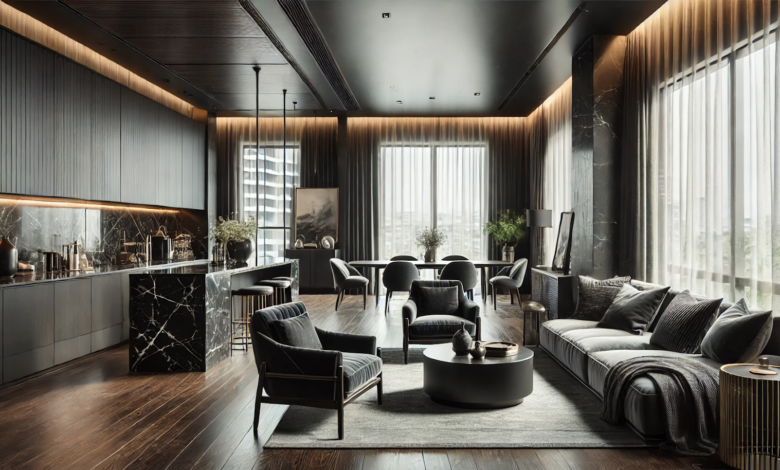The Aesthetic Appeal of Dark Finishes in Home Design

In contemporary home design, the use of dark finishes has become increasingly popular. These finishes add depth, sophistication, and a modern edge to various spaces. Incorporating dark elements can create striking contrasts, highlight architectural features, and imbue a sense of luxury. This article explores the aesthetic appeal of dark finishes, their applications, and tips for integrating them into your home.
The Allure of Dark Finishes
Dark finishes offer a unique combination of elegance and boldness. They can transform a space from ordinary to extraordinary by adding visual interest and a touch of drama.
Visual Depth and Contrast
Dark finishes create a strong visual contrast when paired with lighter colors. This contrast can enhance the perceived depth of a space, making it appear more dynamic and layered. For example, using dark cabinetry in a kitchen with white countertops can create a visually striking and balanced design.
| Aspect | Description |
| Color Contrast | Dark finishes paired with lighter colors to enhance visual depth |
| Material Choices | Black marble, dark-stained wood, dark upholstery |
| Application Examples | Kitchen cabinetry, living room furniture, feature walls |
| Benefits | Creates a dynamic, layered appearance; highlights architectural features |
| Design Tips | Balance dark finishes with ample natural light and lighter decorative accents |
Sophistication and Luxury
Dark tones are often associated with sophistication and luxury. Materials like black marble, dark-stained wood, and charred cladding can elevate the overall look of a room. These finishes can make a bold statement, giving spaces a high-end, polished appearance.
Applications of Dark Finishes
There are numerous ways to incorporate dark finishes into your home. From walls and floors to furniture and accents, these elements can be used in various applications to enhance the aesthetic appeal of your space.
Walls and Cladding
Using dark finishes on walls or cladding can create a dramatic backdrop that highlights other design elements. Charred cladding, for instance, not only provides a unique texture but also adds an element of intrigue and sophistication to exterior and interior walls.
Flooring
Dark flooring options, such as ebony-stained wood or dark tile, can ground a space and add warmth. These finishes work well in both modern and traditional settings, offering versatility and timeless appeal.
Furniture and Accents
Incorporating dark finishes in furniture and decorative accents can add depth and interest to a room. Items like dark-stained tables, black metal fixtures, and dark fabric upholstery can create focal points and enhance the overall design scheme.
Tips for Integrating Dark Finishes
Successfully integrating dark finishes into your home requires thoughtful planning and execution. Here are some tips to help you achieve a balanced and cohesive look:
Balance with Light Elements
When using dark finishes, it’s essential to balance them with lighter elements to prevent a space from feeling too heavy or oppressive. This can be achieved by incorporating light-colored walls, ceilings, and furnishings to create contrast and maintain an open, airy feel.
Use Sparingly
To avoid overwhelming a space, use dark finishes sparingly. Select key areas or elements where dark tones can make the most impact without dominating the entire design. For instance, a feature wall, kitchen island, or statement piece of furniture can be a great place to introduce dark finishes.
Consider Texture and Material
The texture and material of dark finishes play a crucial role in the overall aesthetic. Matte finishes can add a subtle, modern touch, while glossy finishes can create a more luxurious and reflective surface. Combining different textures and materials can add depth and interest to the design.
Numbered List: Steps to Incorporate Dark Finishes
- Assess Your Space: Evaluate the areas in your home where dark finishes can be effectively integrated without overpowering the design.
- Choose Key Elements: Identify key elements such as walls, floors, or furniture pieces where dark finishes will have the most impact.
- Balance with Light: Ensure there is a balance between dark and light elements to maintain a harmonious and inviting atmosphere.
- Select Appropriate Textures: Choose textures and materials that complement the overall design and enhance the aesthetic appeal.
- Experiment with Accents: Use dark finishes in decorative accents to add depth and interest without overwhelming the space.
- Monitor Lighting: Ensure adequate lighting to prevent dark finishes from making the space feel too dim or enclosed.
Conclusion
Dark finishes offer a sophisticated and contemporary touch to home design. By incorporating these elements thoughtfully and balancing them with lighter tones, you can create a space that is both visually stunning and inviting. Whether through walls, floors, furniture, or accents, dark finishes can transform your home into a luxurious and stylish retreat.




